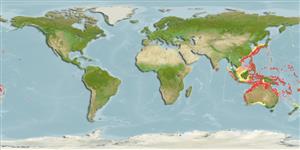Classification / Names
Common names from other countries
Main reference
Size / Weight / Age
Max length : 24.0 cm TL male/unsexed; (Ref. 9824)
Environment
Marine; demersal; depth range 4 - 390 m (Ref. 9824)
Climate / Range
Tropical, preferred ?
Distribution
Eastern Indian Ocean and Western Pacific: Bay of Bengal to southern Japan, Taiwan, New Caledonia, and several areas of the Indo-Australian Archipelago (Ref. 9824).
Countries | FAO areas | Ecosystems | Occurrences | Introductions
Short description
Dorsal
spines
(total): 0;
Dorsal
soft rays
(total): 100-114;
Anal
spines: 0;
Anal
soft rays: 78 - 91. Mouth rather small, contained2. to 2.6 times in head length, maxillary extending to below the anterior margin or anterior 1/3 of lower eye. Gill rakers present on upper limb. Caudal fin with 2 simple rays on upper and lower margins. In the male, several anterior dorsal rays somewhat elongated.
IUCN Red List Status (Ref. 115185)
Threat to humans
Harmless
Human uses
Fisheries: of no interest
More information
ReferencesAquacultureAquaculture profileStrainsGeneticsAllele frequenciesHeritabilityDiseasesProcessingMass conversion
Tools
Special reports
Download XML
Internet sources
Estimates of some properties based on models
Phylogenetic diversity index
PD50 = 0.5000 many relatives (e.g. carps) 0.5 - 2.0 few relatives (e.g. lungfishes)
Trophic Level
3.5 ±0.37 se; Based on food items.
Resilience
Medium, minimum population doubling time 1.4 - 4.4 years (Preliminary K or Fecundity.)
Vulnerability
Low to moderate vulnerability (35 of 100)
Price category
